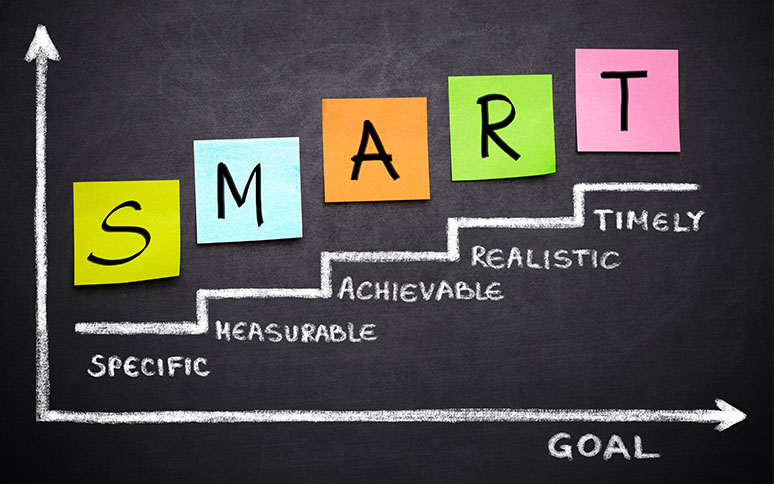It’s a new year and just like everyone else, it’s time to make those resolutions to change or improve yourself. It doesn’t matter if it’s a change in fitness, health, finances, job or anything else that comes to mind, every year most people fail at those resolutions. I hate the term resolution. Instead, I prefer the term goals and the process of goal setting.
By Dave Martinez

Goal setting is different than resolutions. According to Dictionary.com, this is the definition of resolution:
a resolve; a decision or determination: to make a firm resolution to do something.
The problem with a resolution is that it never sets a process of how to accomplish the end result. According to Wikipedia,
Goal setting involves the development of an action plan designed to motivate and guide a person or group toward a goal.
This is one of the reasons I prefer using the term “Goal” & “Goal Setting”. The idea of an action plan means that there will be forward progress.
S.M.A.R.T. Goals
The first time I heard about S.M.A.R.T. goals was when I was in the “corporate” world. I’ll be honest, I hated the process primarily because it was always around what was in the best interest of the company, sometimes at the expense of employees or my values. Since I now work for a company that cares about their employees, I feel much better about this process when it relates to my work. I’m allowed to set my goals that align with my personal values and professional growth. In order for this process to be successful, you’ll need to make sure it lines up with what you want. Since this is about personal goals, that part is done.

- Specific – target a specific area for improvement.
- Measurable – quantify or at least suggest an indicator of progress. Accountability!
- Assignable – specify who will do it. (In this case, it is you!) Specify how!
- Realistic – state what results can realistically be achieved, given available resources.
- Time-related – specify when the result(s) can be achieved.
Here are some examples of how this can be applied in a fitness-oriented goal. Need additional help getting started and sticking with it? Check out Ep. 62 of the RUNATL podcast.
- Specific – Run/walk my first 5K
- Measurable – Register for a 5K
- Assignable – Start a “Couch to 5K” program
- Realistic – How much time do you have to train? Can you accomplish it in 6 weeks or 6 months?
- Time-related – Set a time to complete but also set a time to evaluate your progress. Weekly? Monthly?
Advice On Goal Setting
Here are a few things to remember about setting personal goals, they’re not written in stone, you’re only accountable to yourself, and there’s always a chance that you may not achieve them. That may not sound very motivating so let me explain.
Goals can be a moving target. If you set a time to achieve your goal, you should check in on your progress often. This allows you to evaluate and make changes. If you’re not where you need to be, what changes can you make to help you reach that goal? Do you need to allocate more resources (time, coach, trainer)? Was the goal too high? Should you adjust your time frame? Don’t be discouraged. Also, if you achieve your goal too quickly, then you didn’t set it high enough. Adjust and set a higher goal.
You’re only accountable to yourself which means don’t compare your progress to someone else. If you don’t achieve your personal goal, you don’t have to answer to anyone else. If you achieve it, then take pride in your accomplishment.
What if you don’t achieve your goal? Did you fail? Sometimes you need to dream big and you will stumble but that doesn’t make you a failure. Evaluate what went wrong and learn from it. No matter the end result, you’re farther along and better than you were before you started. Success is measured by forward progress not on whether you achieved a goal.
When I set out to run my first marathon I had set a finish time of 4 hours or faster. It was an achievable goal based on my running history and time. I did the majority of the training on the schedule, however, a few weeks before my marathon I experienced IT Band pain. This caused me to finish at 4:20 missing my finishing goal time. While disappointing, I achieved something I had not before. Running (and some walking) 26.2 miles. I crossed that finish line. I earned that medal.
Once the memory of the pain faded, I signed up again for the same marathon with the same goal. This time I added strength training for the legs to help with any imbalance and weakness that I had in the glutes and lower legs. I finished just under 4 hours the second time around. Since then I’ve done two more marathons and gotten marginally faster. I’ve also upped the distance and done several ultramarathons (50K/31.06 miles) and I’ve got my share of missed goals (even a DNF) at those distances as well. 10 years ago I had only run 2 half-marathons and hated running. I even gave up running for 4 years. Now I enjoy running. It has become a part of my lifestyle and impacted positively me in so many ways. I wouldn’t be at Big Peach, part of this wonderful community if it weren’t for running. Each and every time I’ve missed a goal is an opportunity to learn from it and improve. It’s a lesson that has served me well in all aspects of my life including professionally.
I, along with our entire Big Peach team wish everyone a fantastic year of accomplishments. Feel free to reach out to any of our locations or email us if we can help you out.


